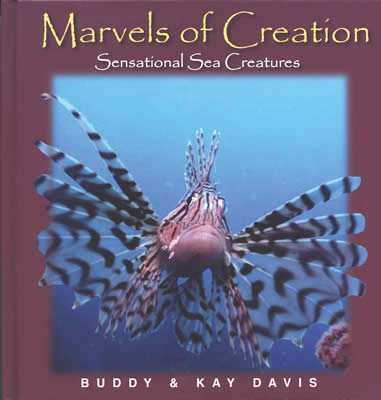Intelligent Design
It has been said that scientists know more about the surface of the moon than they do about the sea. New, wonderfully designed creatures lay hidden in the ocean depths, waiting to be discovered. Within the last five years, many new creatures have been found as we pioneer the sea. We can now explore deeper than ever with specially designed submarines. Some of the most bizarre creatures known to man have come to light, such as the luminous anglers of the deep sea. Over 70 percent of the earth’s surface is covered by water and it is in this unique environment we’ve examined some of its inhabitants.
The great variety of sea life clearly shows the creative genius of God. Evolution dissipates into thin air as the complexities of design shine forth. Anyone with an open mind, capable of thinking logically, will come to the conclusion that the hand of the Lord has done this.
Let’s explore some of the fascinating design features that glorify God as the author of creation.
Shape
The form of fish fall into four categories. Some are compressed and flattened from side to side, such as the grouper. Flounders, on the other hand, are just the opposite. Their body is flattened from top to bottom to suit their needs as a bottom-hugging fish. Then there are the fish that are streamlined in shaped, such as sharks. Lastly, some have snake-shaped bodies, like eels. Each particular form of the species serves that species of fish for its way of life.
Scales
Most fish are covered with scales. Some are extremely small and thin such as the scales of catfish, eel, trout, and paddlefish. Others are very large and heavy like those on sturgeon or the coelacanth. Scales are an outgrowth of the skin or epidermis. They are like fingernails and are semi-transparent.
The number of scales on a fish remains the same as the fish grows. Scales are arranged in a shingle-like fashion over the body of the fish and serve as protection. There are special cells or glands on the scales that produce the slime for which fish are famous. The slime protects the fish against diseases and fungal infections. This mucus also enables the fish to move through the water without friction. The slippery mucus can help a fish get away when caught by man or beast.
Color
Fish come in a wide, wonderful array of colors. Tropical fish advertise their beauty, and some of them have the most glorious range of colors on earth. Others are dull to blend into their environment. The color of some fish may vary from one geographical range to another and also a change in depth may change color. Some fish can even change colors like a chameleon. In the skin of most fish are pigment cells that produce their color. Scientists have discovered that the pigment cells, or chromatophores, are connected to the nervous systems of some species. Scientists also believe that the eye of the fish is connected by nerves to pigment cells to help the fish blend into its habitat.
The Creator also designed some sea creatures to produce light. Like miniature Christmas lights, the fish glows or twinkles in the dark ocean depths.
Gills
God designed the fish with gills to remove oxygen form the water. Capillaries that lie close to the surface of the gills absorb the oxygen and at the same time expel the waste, carbon dioxide. Fish differ in their ways of breathing—by pumping water through their mouth, by their gill covers, or by swimming through the water.
Hearing
Not long ago, scientists felt that the hearing organs of fish were poorly developed and did not serve much purpose. We now know, because of the invention of the hydrophone, that the sea is full of sound. Fish have only an inner ear. Fish and mammals make sounds by vibrating parts of their body or by grinding their teeth. Fin whales can produce sounds that may have been detected more than 2,000 miles away. Whales and dolphins make a variety of sounds as they communicate with one another. Most fish sounds are grunts, barks, clicks, or growls. Most marine sounds are produced to attract a mate or frighten a potential enemy.
Sight
Fish eyes were designed for underwater vision. The lens of a fish is globular. The lens is rigid and incapable of changing. The lens works similar to that in a camera and moves toward or away from the retina. There is little focal action in the eye because visibility is only about 82 feet (25 m) underwater. Most fish see in color, the exception being the deep-sea dwellers. This is known by the number of color receptor cells located on the retina. Most fish do not have eyelids like mammals because fish eyes are constantly bathed by water.
Bladders
Nearly all fish, with the exception of sharks, mackerels, flounders, and a few others, have a swim bladder which is an air-filled sac under the backbone. This bladder allows the fish to adjust its buoyancy as needed. The fish receives gas into the sac through the blood stream or it can return it.
All of this information that allows these creatures to survive could not have happened by time and chance acting on matter. We haven’t scratched the surface concerning the design of fish, having looked at only a few of the 40,000 species.
Origin of Fish
The fossil record is clear. The first time you find a fish in the fossil record, it is 100 percent fish. This isn’t what evolutionists would expect if evolution were true. According to evolution, there should be abundant fossil evidence showing the transition from invertebrate to vertebrate. A.S. Romer writes in his book, Vertebrate Paleontology, that the “common ancestor of bony fish groups is unknown.” Romer also writes that placoderms pose a deep problem for evolution and that evolution would be better without them. He said that the origin of bony fishes is a “dramatically sudden one.”
Marvels of Creation: Sensational Sea Creatures
Brings the world of the sea alive in a unique and colorful way with photographs, a page of facts and commentaries.
Browse Kids BookRecommended Resources
- © 2024 Answers in Genesis
- Privacy Policy
- Contact
- About



